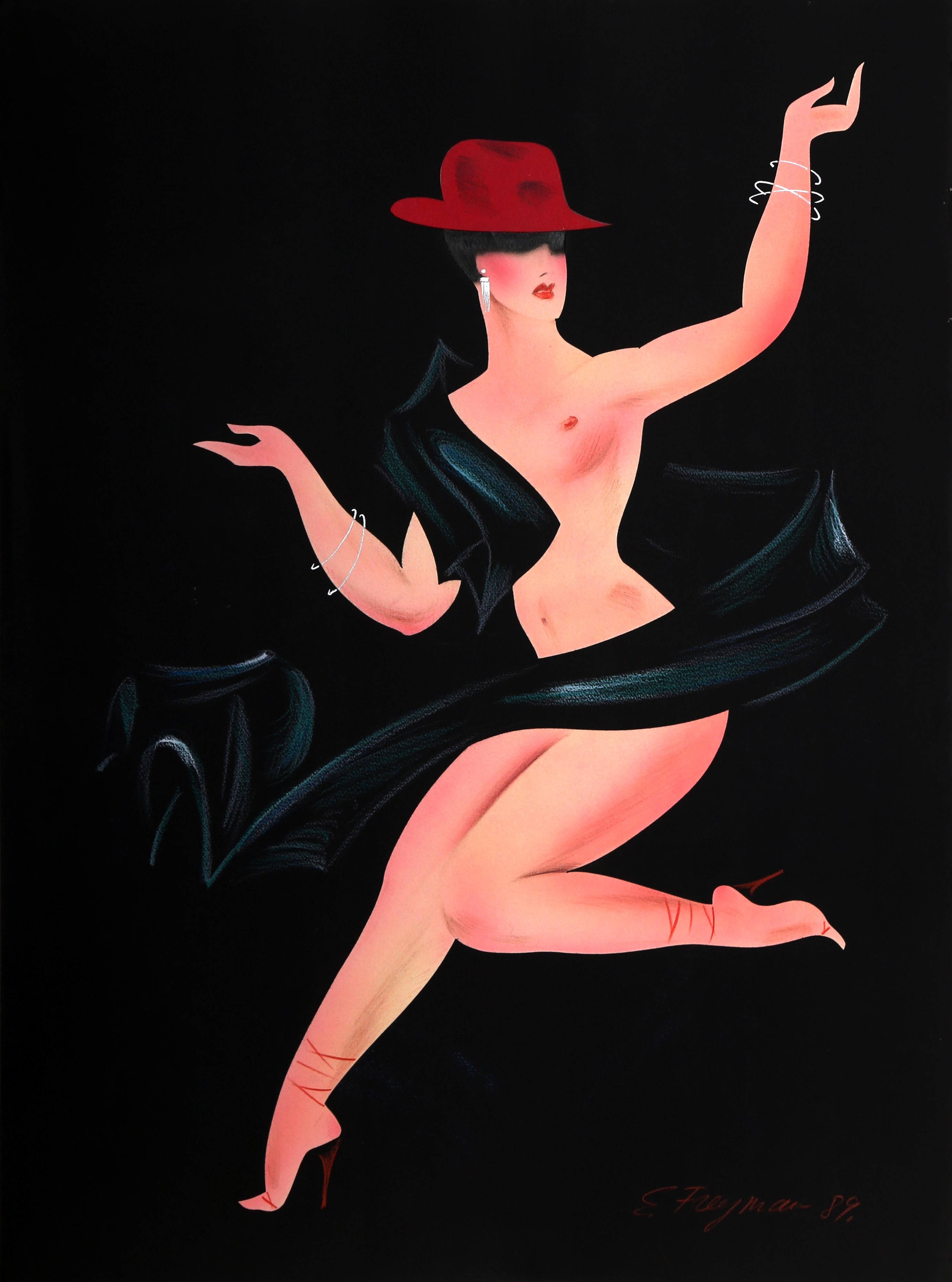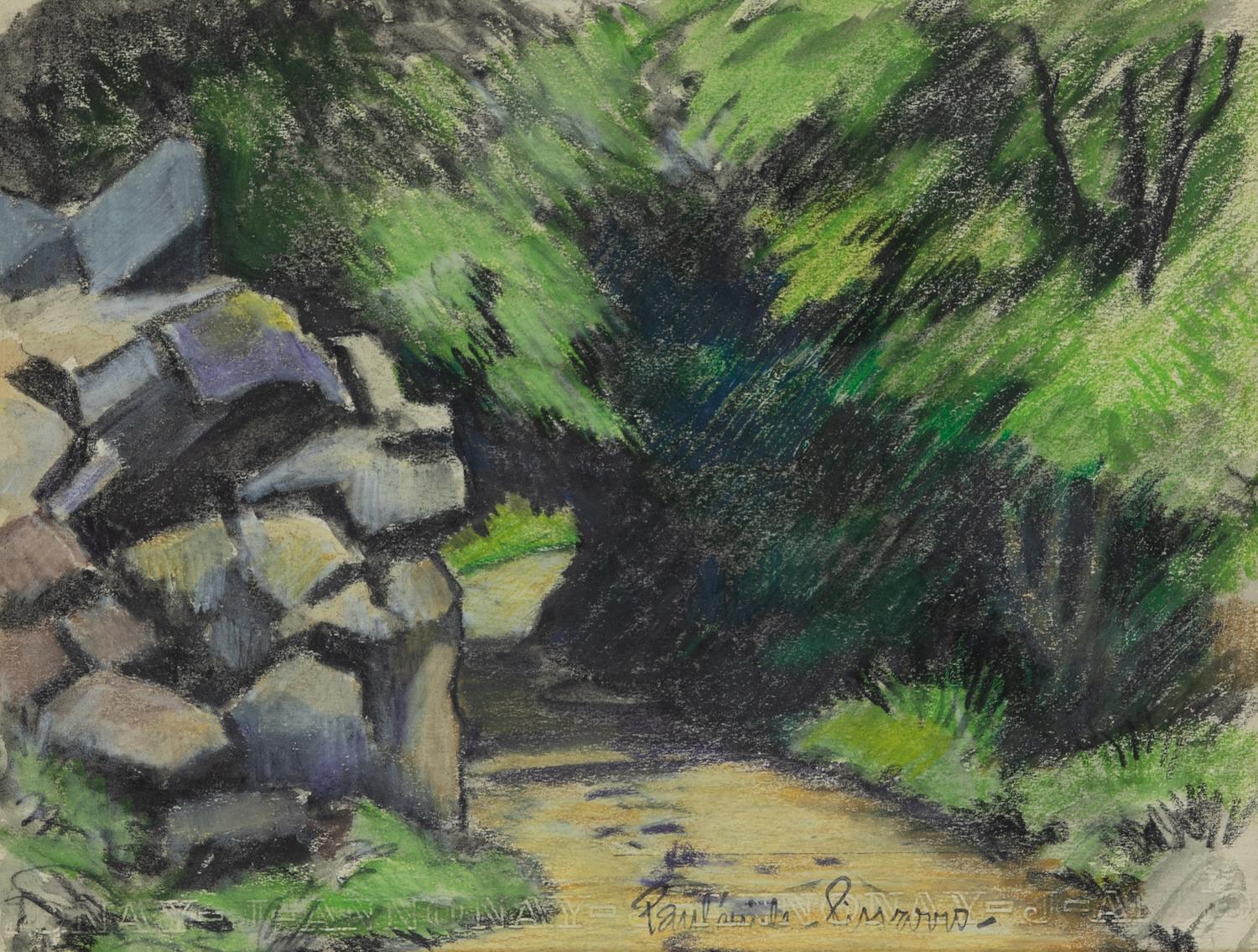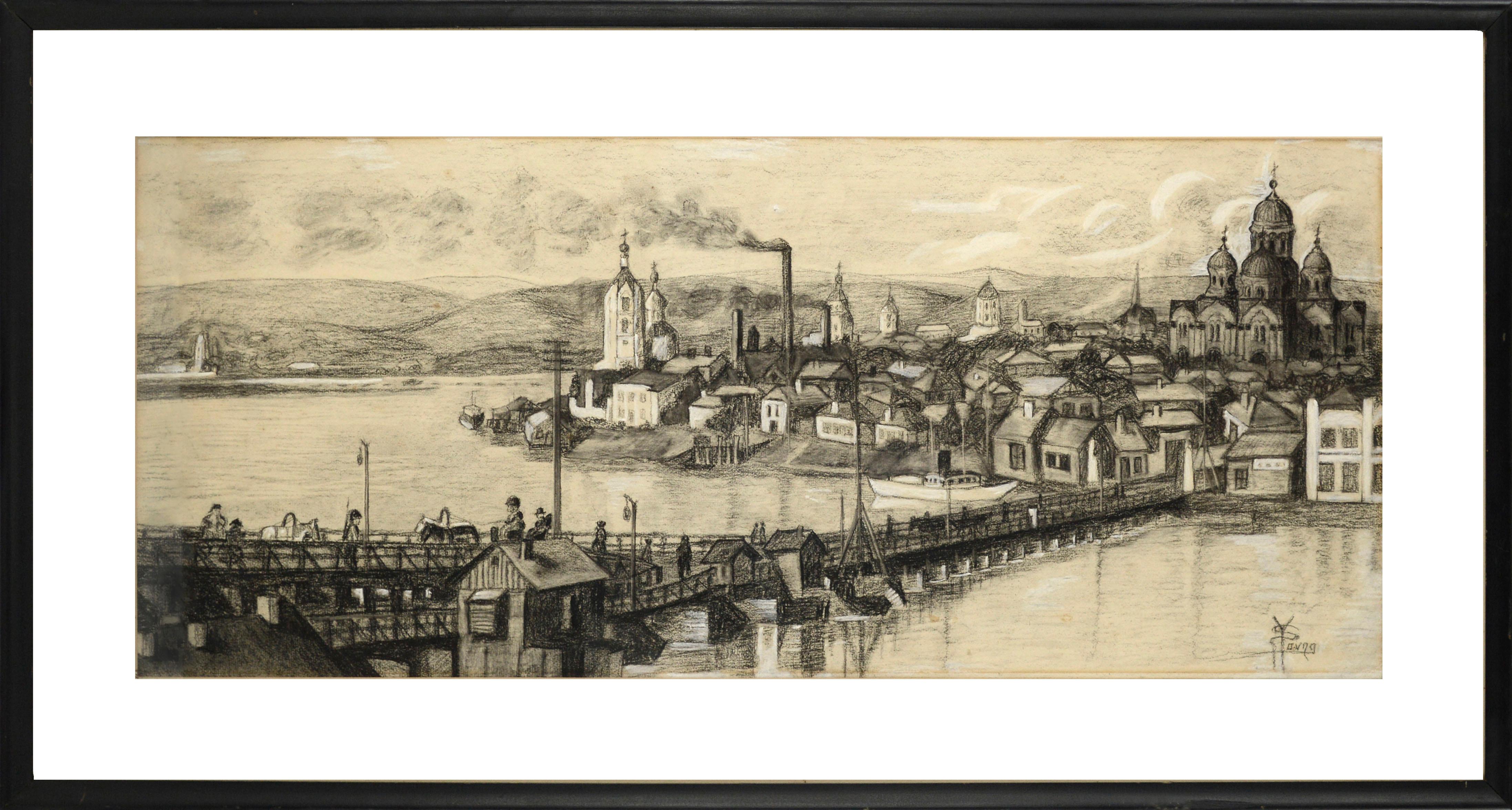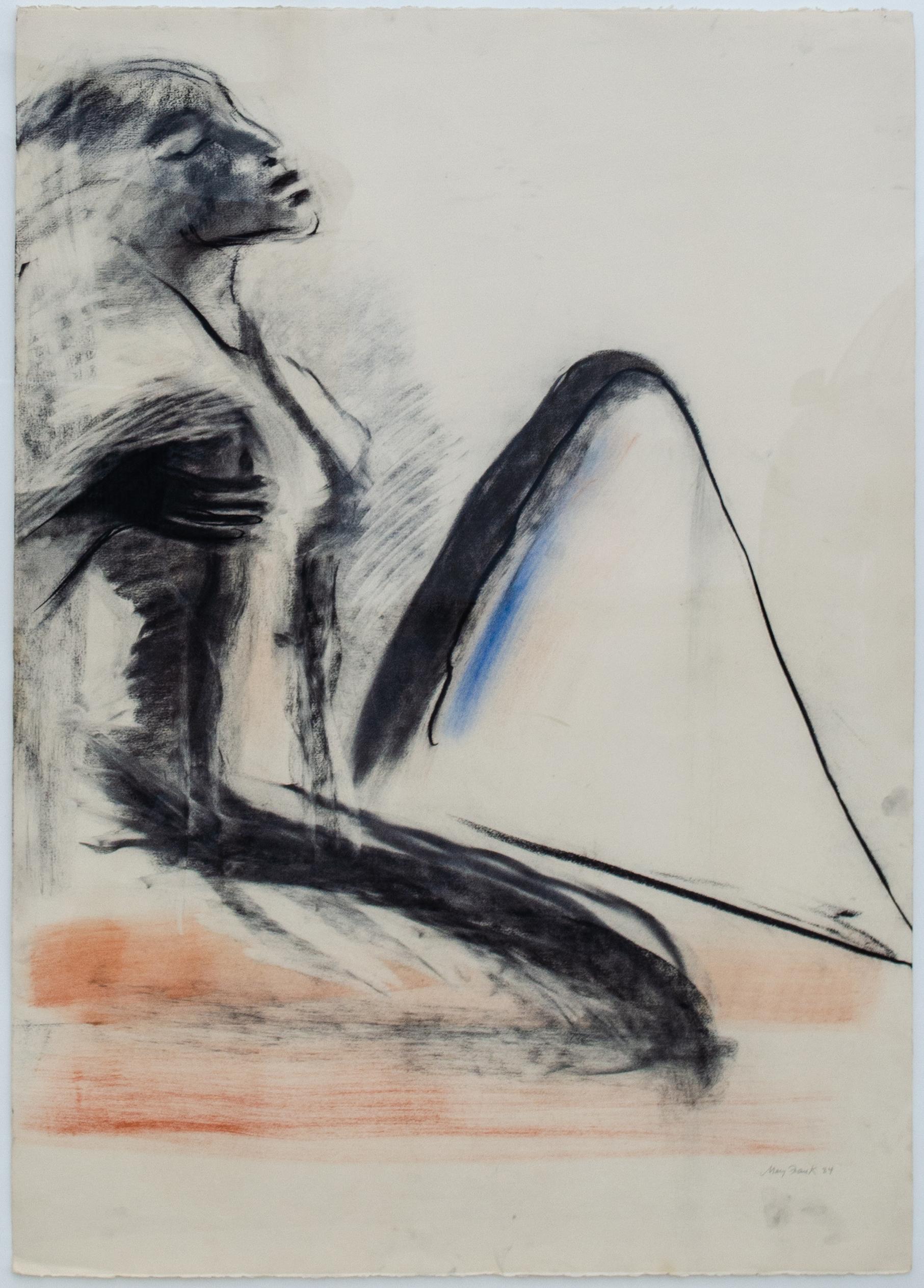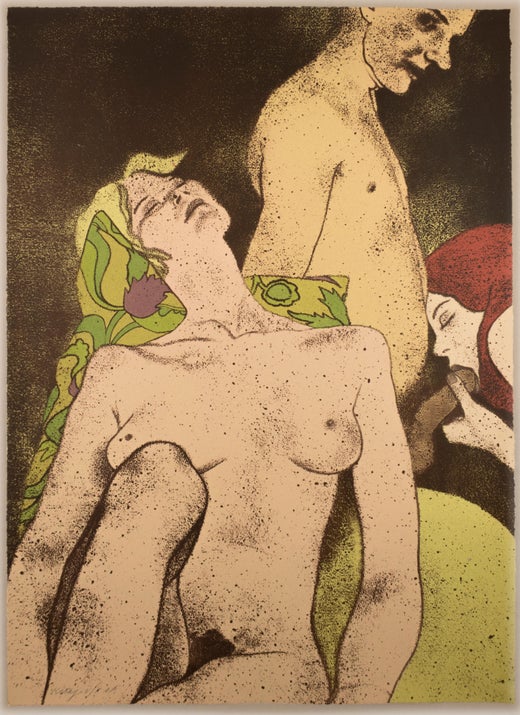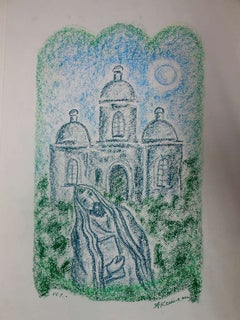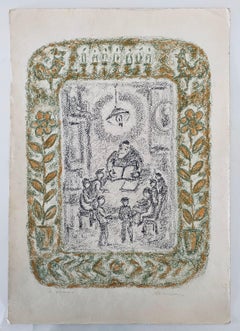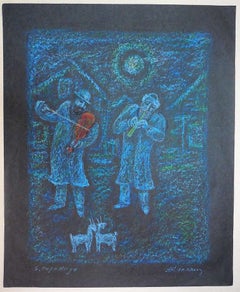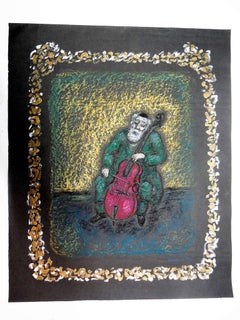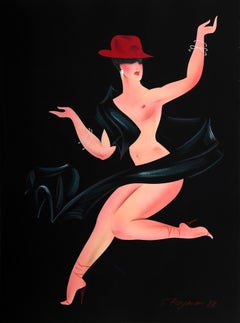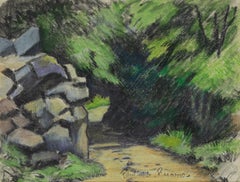Items Similar to Dr Claribel & Miss Etta (Cone Sisters) British Pop Artist Kitaj Pastel Drawing
Want more images or videos?
Request additional images or videos from the seller
1 of 12
Ronald Brooks KitajDr Claribel & Miss Etta (Cone Sisters) British Pop Artist Kitaj Pastel Drawing1997-2000
1997-2000
About the Item
Ronald Brooks Kitaj RA 1932 – 2007 was an American artist with Jewish roots who spent much of his life in England. He became a merchant seaman with a Norwegian freighter when he was 17. He studied at the Akademie der bildenden Künste in Vienna and the Cooper Union in New York City. After serving in the United States Army for two years, in France and Germany, he moved to England to study at the Ruskin School of Drawing and Fine Art in Oxford (1958–59) under the G.I. Bill, where he developed a love of Cézanne, and then at the Royal College of Art in London (1959–61), alongside David Hockney, Derek Boshier, Peter Phillips, Allen Jones and Patrick Caulfield. Richard Wollheim, the philosopher and David Hockney remained lifelong friends.
"Through an earlier pre-occupation with turn-of-the-century intellectual life in Vienna (where he had started his art studies in the early 1950s), as well as an admiration for the Warburg Institute approach to the history of art-in-its-intellectual-context (since after Vienna he had moved to Oxford to study with the art historian Edgar Wind, before going on to the Royal College of Art) Kitaj has come to identify most strongly with the central European Jewish writer Franz Kafka, and with his sense of estrangement and of hidden mysteries. Illustrations to Kafka's aphorisms, imaginary portraits of his fiancée Felice and Count West-West who owned The Castle, appear in the Little Pictures, as do rapidly sketched portraits of Karl Kraus, Paul Celan, Leon Trotsky and Ludwig Wittgenstein, representations of Judeo-Christian mysteries of the hidden face of God.
Kitaj settled in England, and through the 1960s taught at the Ealing Art College, the Camberwell School of Art and the Slade School of Art. He also taught at the University of California, Berkeley in 1968. He staged his first solo exhibition at Marlborough New London Gallery in London in 1963, entitled "Pictures with commentary, Pictures without commentary", in which text included in the pictures and the accompanying catalogue referred to a range of literature and history, citing Aby Warburg's analysis of symbolic forms as a major influence.
He curated an exhibition for the Arts Council at the Hayward Gallery in 1976, entitled "The Human Clay" (an allusion to a line by W. H. Auden), including works by 48 London artists, such as William Roberts, Richard Carline, Colin Self and Maggi Hambling, championing the cause of figurative art at a time when abstract was dominant. In an essay in the controversial catalogue, he invented the phrase the School of London to describe painters such as Frank Auerbach, Leon Kossoff, Francis Bacon, Lucian Freud, Euan Uglow, Michael Andrews, Reginald Gray, Peter de Francia and himself.
Kitaj had a significant influence on British pop art, with his figurative paintings featuring areas of bright colour, economic use of line and overlapping planes which made them resemble collages, but eschewing most abstraction and modernism.[citation needed] Allusions to political history, art, literature and Jewish identity often recur in his work, mixed together on one canvas to produce a collage effect. He also produced a number of screen-prints with printer Chris Prater. He told Tony Reichardt, manager of the Marlborough New London Gallery, that he made screen-prints as sketches for his future paintings. From then onwards Tony Reichardt commissioned Chris Prater to print three or four copies of every print he made on canvas. His later works became more personal.
Kitaj was recognised as being one of the world's leading draftsmen, almost on a par with, or compared to, Degas. Indeed, he was taught drawing at Oxford by Percy Horton, whom Kitaj claimed was a pupil of Walter Sickert, who was a pupil of Degas; and the teacher of Degas studied under Ingres. He staged a major exhibition at Los Angeles County Museum of Art in 1965, and a retrospective at the Hirshhorn Museum in Washington, D.C. in 1981. He selected paintings for an exhibition, "The Artist's Eye", at the National Gallery, London in 1980. In 1981 he was elected into the National Academy of Design as an Associate member and became a full Academician in 1984.
In his later years, he developed a greater awareness of his Jewish heritage, which found expression in his works, with reference to the Holocaust and influences from Jewish writers such as Kafka and Walter Benjamin, and he came to consider himself to be a "wandering Jew". In 1989, Kitaj published "First Diasporist Manifesto", a short book in which he analysed his own alienation, and how this contributed to his art. His book contained the remark: "The Diasporist lives and paints in two or more societies at once." And he added: "You don't have to be a Jew to be a Diasporist."
A second retrospective was staged at the Tate Gallery in 1994. the exhibition moved to the Metropolitan Museum of Art in New York and afterwards to the Los Angeles County Museum of Art in 1995. Kitaj was elected to the Royal Academy in 1991, the first American to join the Academy since John Singer Sargent. He received the Golden Lion at the Venice Biennale in 1995. He staged another exhibition at the National Gallery in 2001, entitled "Kitaj in the Aura of Cézanne and Other Masters".
In September 2010, Kitaj and five British artists including Howard Hodgkin, John Walker, Ian Stephenson, Patrick Caulfield and John Hoyland were included in an exhibition entitled The Independent Eye: Contemporary British Art From the Collection of Samuel and Gabrielle Lurie, at the Yale Center for British Art.
In October 2012 a major international symposium was held in Berlin to mark what would have been Kitaj's 80th birthday. It accompanied Obsessions, the first comprehensive exhibition of Kitaj's work since his death, held at the Jewish Museum, Berlin. The exhibition was shown in the UK in two parts at Pallant House Gallery, Chichester and the Jewish Museum London.
- Creator:Ronald Brooks Kitaj (1932-2007, American)
- Creation Year:1997-2000
- Dimensions:Height: 22 in (55.88 cm)Width: 30 in (76.2 cm)
- Medium:
- Movement & Style:
- Period:
- Condition:
- Gallery Location:Surfside, FL
- Reference Number:1stDibs: LU38212300972
Ronald Brooks Kitaj
Born in Cleveland, Ohio in 1932, R.B. (Ronald Brooks) Kitaj is considered a key figure in European and American contemporary painting. While his work has been considered controversial, he is regarded as a master draftsman with a commitment to figurative art. His highly personal paintings and drawings reflect his deep interest in history; cultural, social and political ideologies; and issues of identity. Among his various honors are election to the American Academy of Arts and Letters in 1982, and election to the Royal Academy in 1985 (the first American since John Singer Sargent to receive this honor.) Numerous retrospective exhibitions of his work include shows at the Hirshhorn Museum in Washington, D.C.; The Jewish Museum, Berlin; The Jewish Museum, London; and the Hamburger Kunsthalle in Germany. Raised in Cleveland, Ohio, and Troy, New York, Kitaj joined the Merchant Marines in 1949.
In 1950, between sailings, he attended classes at the Cooper Union for the Advancement of Science and Art in New York. He went on to study drawing at the Academy of Fine Art in Vienna, Austria. Kitaj moved to Oxford, England in 1957, and enrolled at The Ruskin School of Drawing and Fine Art, University of Oxford. In 1959, Kitaj was accepted into Royal College of Art, London, where he befriended classmate David Hockney. Upon graduation from the RCA, Kitaj signed with Marlborough Fine Art, London, where he had his first solo exhibition in 1963. His art career began in earnest, and he found critical acclaim alongside commercial success. A second solo show followed at Marlborough Gallery, New York, in 1965, and he sold “The Ohio Gang” to The Museum of Modern Art. In 1969, Kitaj taught for a year at the University of California, Los Angeles. In 1976, he coined the term “School of London” in an essay he wrote as curator of the polemical exhibition, “The Human Clay,” at the Hayward Gallery, London. The term, though loose, continues to define a group of stylistically diverse artists, including Kitaj, who were working in London at that time focusing on figural representation. In 1981, he spent a year in Paris, France, where he focused on drawing and use of pastel. In 1994, the Tate Gallery, London, organized a major retrospective of Kitaj’s work. Hostile and personal attacks from some critics led to what Kitaj referred to as the “Tate War.” The exhibition subsequently traveled to the Los Angeles County Museum of Art and the Metropolitan Museum of Art, New York. Kitaj moved to Los Angeles, California, and continued to exhibit with Marlborough Fine Art and the Marlborough Gallery, New York. In 2001 the National Gallery London organized a solo exhibition of paintings: “R.B. Kitaj In the Aura of Cezanne and Other Masters.” Kitaj focused on his “late style” in his Yellow Studio in Westwood and died in 2007. His gift of his archive to the UCLA Library Special Collections was celebrated with exhibitions at the Skirball Cultural Center and UCLA’s Young Research Library.
About the Seller
4.9
Platinum Seller
Premium sellers with a 4.7+ rating and 24-hour response times
Established in 1995
1stDibs seller since 2014
1,760 sales on 1stDibs
Typical response time: 1 hour
- ShippingRetrieving quote...Shipping from: Surfside, FL
- Return Policy
Authenticity Guarantee
In the unlikely event there’s an issue with an item’s authenticity, contact us within 1 year for a full refund. DetailsMoney-Back Guarantee
If your item is not as described, is damaged in transit, or does not arrive, contact us within 7 days for a full refund. Details24-Hour Cancellation
You have a 24-hour grace period in which to reconsider your purchase, with no questions asked.Vetted Professional Sellers
Our world-class sellers must adhere to strict standards for service and quality, maintaining the integrity of our listings.Price-Match Guarantee
If you find that a seller listed the same item for a lower price elsewhere, we’ll match it.Trusted Global Delivery
Our best-in-class carrier network provides specialized shipping options worldwide, including custom delivery.More From This Seller
View AllShtetl Scene with Synagogue "Prayer"
By Anatoli Lvovich Kaplan
Located in Surfside, FL
Pastel or Tempera on paper. Judaica Shtetl scene of village. A Jew with Talith and Tefillin in front of the Synagogue.
Anatoli Lwowitch Kaplan was a Russian painter, sculptor and pri...
Category
20th Century Modern Landscape Drawings and Watercolors
Materials
Pastel, Tempera
Shtetl Interior, Cheyder
By Anatoli Lvovich Kaplan
Located in Surfside, FL
Pastel or Tempera on paper. Judaica Shtetl scene of village.
Anatoli Lwowitch Kaplan was a Russian painter, sculptor and printmaker, whose works often reflect his Jewish origins.
h...
Category
20th Century Modern Figurative Drawings and Watercolors
Materials
Pastel, Tempera
Russian Judaica Shtetl Klezmer Musicians
By Anatoli Lvovich Kaplan
Located in Surfside, FL
Pastel or Tempera on paper. Judaica Shtetl scene of village.
Anatoli Lwowitch Kaplan was a Russian painter, sculptor and printmaker, whose works often reflect his Jewish origins.
h...
Category
20th Century Modern Figurative Drawings and Watercolors
Materials
Pastel, Tempera
Shtetl Klezmer Musician painting and drawing
By Anatoli Lvovich Kaplan
Located in Surfside, FL
Pastel or Tempera on paper. Judaica Shtetl scene of village. This one depicts a Klezmer musician fiddler playing his violin.
Anatoli Lwowitch Kaplan ...
Category
20th Century Modern Figurative Drawings and Watercolors
Materials
Pastel, Tempera
Pastel on paper Shtetl Scene
By Anatoli Lvovich Kaplan
Located in Surfside, FL
Pastel or Tempera on paper. Judaica Shtetl scene of village.
Anatoli Lwowitch Kaplan was a Russian painter, sculptor and printmaker, whose works often reflect his Jewish origins.
h...
Category
20th Century Modern Figurative Drawings and Watercolors
Materials
Pastel
Portrait of a Rabbi
By Boris Deutsch
Located in Surfside, FL
Boris deutsch was born in krasnagorka lithuania june 4 1892 died in los angeles 1978.Entered the polytechnic school in riga 1905.School of applied arts berlin 1912. Settled in l.A. 1...
Category
20th Century Modern Figurative Drawings and Watercolors
Materials
Pastel, Mixed Media, Tempera, Watercolor
You May Also Like
Dancing Semi-Nude, Fashion Art by Erik Freyman
By Erik Freyman
Located in Long Island City, NY
An 80's style Art Deco work on paper of a Dancing Nude Lady by contemporary artist Erik Freyman.
Collage with pastels on paper, signed lower right.
Category
1980s Pop Art Portrait Drawings and Watercolors
Materials
Paper, Pastel
Animal Farm from Grown Ups, Pastel on Paper Drawing by Darrell Fusaro
Located in Long Island City, NY
Artist: Darrell Fusaro, American (1962 - )
Title: Animal Farm from Grown-Ups
Year: circa 1990
Medium: Pastel on Paper, signed l.l.
Size: 22 x 30 in. (55.88 x 76.2 cm)
Category
1990s Pop Art Figurative Drawings and Watercolors
Materials
Pastel, Archival Paper
Outside with Parents from Grown Ups, Pastel Drawing by Daniel Fusaro
By Daniel Fusaro
Located in Long Island City, NY
Artist: Darrell Fusaro, American (1962 - )
Title: Outside with Parents from Grown Ups
Year: circa 1990
Medium: Pastel on Paper, signed l.l.
Size: 22 x 29.5 in. (55.88 x 74.93 cm)
Fra...
Category
1990s Pop Art Figurative Drawings and Watercolors
Materials
Pastel
Un Chemin dans la Forêt by Paulémile Pissarro - Pastel and charcoal drawing
By Paul Emile Pissarro
Located in London, GB
Un Chemin dans la Forêt by Paulémile Pissarro (1884-1972)
Pastel and charcoal on paper
24 x 31 cm (9 ¹/₂ x 12 ¹/₄ inches)
Stamped lower middle-right, Paulémile Pissarro
Provenance
E...
Category
Mid-20th Century Post-Impressionist Figurative Drawings and Watercolors
Materials
Charcoal, Paper, Pastel
View of Tallinn, Estonia - Figurative Landscape Panoramic Charcoal Drawing
Located in Soquel, CA
A sweeping view of Tallinn, Estonia by an unknown artist (20th Century). This detailed charcoal landscape drawing shows a panorama of the beautiful coastal city on the Baltic Sea, complete with small figures walking on a pier, boats in the harbor, and the iconic Alexander Nevsky...
Category
Early 20th Century Impressionist Landscape Drawings and Watercolors
Materials
Paper, Charcoal, Pastel
Mary Frank Original Charcoal and Pastel 1984 Figure Drawing
By Mary Frank
Located in New York, NY
Mary Frank (British/American, b. 1933)
Chant, 1984
Charcoal and pastel on paper
41 3/4 x 29 3/4 in.
Framed: 46 1/2 x 34 1/4x 2 in.
Signed and dated lower right: Mary Frank 84
Midtown Payson Galleries Label Verso
Mary Frank is known for creating stoneware sculptures that have the appearance of terra cotta fragments dug up at an archaeological site. Sometimes a half-finished relief head...
Category
1980s Modern Nude Drawings and Watercolors
Materials
Paper, Charcoal, Pastel
Recently Viewed
View AllMore Ways To Browse
Three Sisters Art
Cezanne Drawings
Sketch Pop Art
Drawings Of Singers
Slade School Artist
Two Sisters Vintage
Four Sisters
Vintage Lion Drawing
Three Sisters Print
Three Sisters Vintage
Jewish Pop Art
German Pastel Portrait
Lion Art By England
Bill Jones
Peter Samuels
Robert Jones Drawing
Frank Golden Painting
Chris West
